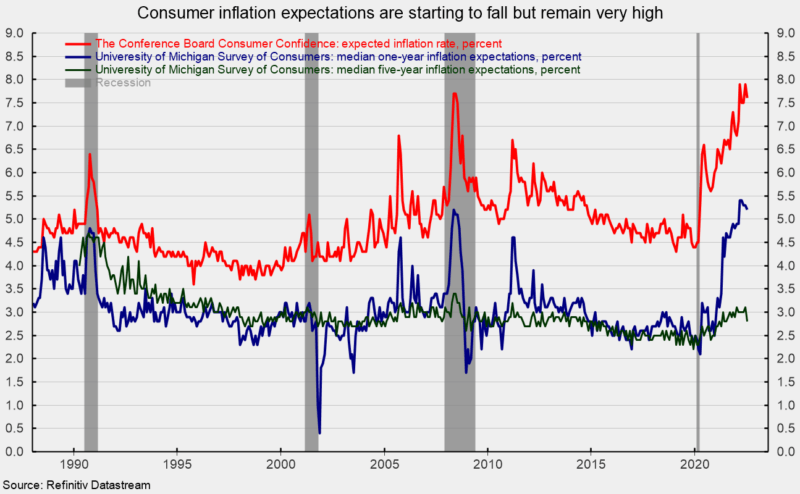The Consumer Confidence Index from The Conference Board fell again in July, the third drop in a row and eighth in the last thirteen months. The composite index decreased 2.7 points or 2.7 percent to 95.7, the lowest level since February 2021 (see first chart). From a year ago, the index is down 23.5 percent. Both components declined in July.
The expectations component sank 0.5 points, or 0.8 percent, to 65.3 (see first chart) while the present-situation component – one of AIER’s Roughly Coincident Indicators – fell 5.9 points to 141.3 (see first chart). The expectations index is down 37.1 percent from a year ago and is at its lowest level since March 2013. The index is below the readings just before the start of all but one of the last eight recessions.
Within the expectations index, just one of the three components fell versus June. The index for expectations for higher income fell 1.4 points to 14.7 while the index for expectations for lower income rose 0.4 points, leaving the net (expected higher income – expected lower income) down 1.8 points to -1.0.
The index for expectations for better business conditions fell 0.6 points to 14.0 while the index for expected worse conditions fell 2.5 points, leaving the net (expected business conditions better – expected business conditions worse) up 1.9 points, but still at -13.2.
The outlook for the jobs market improved marginally in July as the expectations for more jobs index fell 0.2 points to 15.7 while the expectations for fewer jobs index fell by 0.8 points to 21.4, putting the net up 0.6 points to -5.7. For the present situation index components, current business conditions and employment conditions weakened. The net reading for current business conditions (current business conditions good – current business conditions bad) was -7.0 in July, down from -3.3 in June. Current views for the labor market saw the jobs hard to get index increase, rising 0.7 points to 12.3 as the jobs plentiful index fell 1.4 points to a still-strong 50.1 resulting in a 2.1-point drop in the net to 37.8.
Inflation expectations eased down to 7.6 percent in July from 7.9 percent in June; expectations were 4.4 percent in January 2020 (see second chart). The sharp rise in expected inflation from The Conference Board survey is consistent with the University of Michigan survey results, though the magnitudes are different (see second chart). Inflation expectations remain extremely high as prices for many goods and services continue to rise at an elevated pace. The extreme outlook for inflation is a key driver of weaker consumer expectations. According to the report, “The decrease was driven primarily by a decline in the Present Situation Index—a sign growth has slowed at the start of Q3. The Expectations Index held relatively steady but remained well below a reading of 80, suggesting recession risks persist. Concerns about inflation—rising gas and food prices, in particular—continued to weigh on consumers.”
The surge in prices for many consumer goods and services is largely a function of shortages of materials, a tight labor market, and logistical issues that prevent supply from meeting a post-lockdown-recession surge in demand, though there has been significant progress boosting production. Price pressures have been compounded by surging energy prices as a result of the Russian invasion of Ukraine and periodic lockdowns in China. Furthermore, the intensifying Fed tightening cycle raises the risk of a policy mistake and adds to the extreme level of risk and uncertainty in the overall economic outlook.




